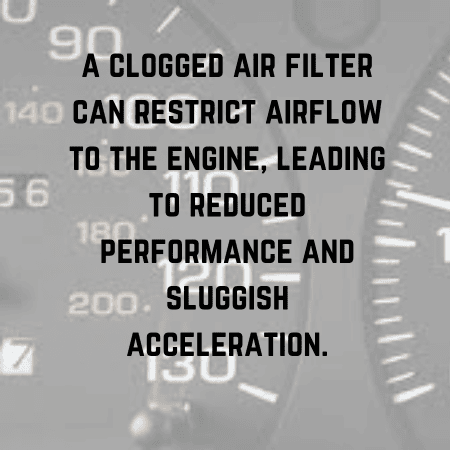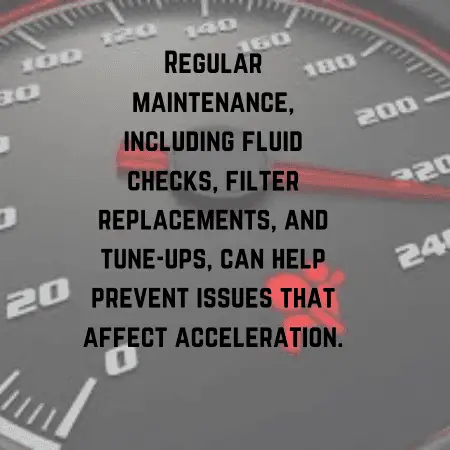You’re cruising down the road, pressing the gas pedal, but your car just won’t pick up speed. Yet, strangely, the RPM meter climbs higher and higher. It’s a frustrating scenario that many drivers encounter. But fear not, as we delve into the possible reasons behind this issue and explore how to address it effectively. So keep on reading…
Why my car won’t accelerate but RPMs go up? When your car won’t accelerate but the RPMs go up, it usually means there’s a problem with how the engine’s power is getting to the wheels. This can happen because of issues like a slipping transmission, worn-out clutch (in manual cars), clogged fuel filter, or problems with sensors that tell the engine how much gas to give. Even though the engine is working harder and spinning faster (that’s why the RPMs go up), the power isn’t reaching the wheels properly, so the car doesn’t speed up as it should.

signs of a car won’t accelerate but RPMs go up
When your car won’t accelerate despite the RPMs increasing, there are several signs you might notice:
- Lack of Forward Movement: One of the most obvious signs is that the car doesn’t respond to pressing the accelerator pedal as expected. Even though you’re giving it gas, the car doesn’t move forward or accelerate very slowly.
- High Engine Revving: You’ll likely observe the engine’s RPMs climbing higher than usual, indicating that the engine is working harder. However, this increased engine speed doesn’t translate into faster acceleration or increased vehicle speed.
- Sluggish Response: Even when you press the gas pedal firmly, the car responds sluggishly, taking longer than usual to pick up speed or struggling to reach higher speeds.
- Difficulty Climbing Hills: If you encounter a hill or incline, you may notice that the car struggles to maintain speed or loses speed despite pressing the gas pedal.
- Unusual Engine Sounds: You might hear abnormal engine noises, such as revving or whining, as the engine works harder to overcome the acceleration issue.
- Jerking or Shaking: In some cases, the car may jerk or shake as you attempt to accelerate, indicating a lack of smooth power delivery to the wheels.
- Check Engine Light: Depending on the underlying cause, the check engine light (CEL) may illuminate on the dashboard. This warning light indicates that the car’s onboard diagnostics system has detected a problem, which could be related to the acceleration issue.
- Decreased Fuel Efficiency: Poor acceleration can lead to increased fuel consumption since the engine is working harder to maintain speed. You may notice a decrease in fuel efficiency or more frequent visits to the gas station.
Ignoring acceleration problems can lead to further damage to engine or transmission components and potentially compromise your safety on the road.
reasons why a car won’t accelerate but RPMs go up
When a car won’t accelerate but the RPMs (revolutions per minute) go up, it usually means there’s a problem with the engine or transmission. Here are some simple reasons why this might happen:
Slipping Transmission: The transmission is like the car’s gearbox. If it’s slipping, it can’t transfer power properly from the engine to the wheels, even though the engine is revving up.
Worn-out Clutch: In manual transmission cars, the clutch is what connects the engine to the transmission. If it’s worn out, it might slip, preventing the car from accelerating even though the engine is working harder.
Clogged Fuel Filter: A clogged fuel filter can restrict the flow of fuel to the engine, making it struggle to generate power, which results in poor acceleration.
Faulty Throttle Position Sensor: This sensor tells the car’s computer how much throttle you’re giving it. If it’s faulty, the engine might not be getting the right amount of fuel, leading to poor acceleration.
Engine Misfire: If one or more cylinders in the engine aren’t firing properly, it can cause a lack of power, even though the engine is revving up.
Air Intake Issues: If there’s a problem with the air intake system, such as a clogged air filter or a vacuum leak, the engine might not be getting enough air, which can affect its performance.

how to Diagnose the Problem car won’t accelerate but RPMs go up
1- Visual Inspection:
Start by visually inspecting the exterior and under the hood of the car. Look for any signs of damage, leaks, or loose components. Check the hoses, belts, and wiring to ensure everything is intact and properly connected. Sometimes, a visual inspection can reveal obvious issues like a disconnected hose or a leaking fluid that could be causing the problem.
2- Listen for Unusual Sounds:
When you start the car and attempt to accelerate, pay close attention to any strange noises coming from the engine or other components. These noises could include grinding, knocking, whining, or hissing sounds. Each type of sound may indicate a different underlying issue, such as engine mechanical problems, worn-out components, or leaks in the intake or exhaust system.
3- Feel for Abnormal Sensations:
As you try to accelerate, notice how the car responds. Does it hesitate or jerk when you press the gas pedal? Does it feel sluggish or shaky? These sensations can provide valuable clues about the nature of the problem. For example, hesitation or jerking could indicate issues with the fuel delivery system, while shaking or rough idling might suggest engine misfires or exhaust system problems.
4- Transmission Fluid Check:
Inspect the transmission fluid level and condition. Low or dirty transmission fluid can impair the transmission’s ability to transfer power from the engine to the wheels efficiently. If the fluid level is low or if the fluid appears dark or contaminated, it may indicate a leak or the need for a fluid change.
5- Air Intake System Inspection:
Examine the air intake system, including the air filter, intake ducts, and throttle body. A dirty or clogged air filter can restrict airflow to the engine, leading to reduced performance and acceleration. Remove the air filter and inspect it for dirt, debris, or signs of clogging. Clean or replace the air filter as needed.
6- Testing the Throttle Position Sensor (TPS):
The throttle position sensor (TPS) monitors the position of the throttle pedal and sends signals to the engine control unit (ECU) to adjust fuel delivery accordingly. A malfunctioning TPS can cause the ECU to misinterpret throttle inputs, resulting in poor acceleration. To test the TPS, you can use a multimeter to measure voltage changes as you move the throttle pedal.
7- Engine Misfire Detection:
Engine misfires occur when one or more cylinders fail to ignite the air-fuel mixture properly. Common causes of misfires include faulty spark plugs, ignition coils, fuel injectors, or engine mechanical issues such as low compression. You can use a scan tool to identify misfire codes stored in the vehicle’s computer and perform further diagnostic tests to pinpoint the underlying cause.
9- Fuel System Inspection:
Inspect the fuel system components, including the fuel pump, fuel filter, and fuel injectors. A weak fuel pump or clogged fuel filter can restrict fuel delivery to the engine, leading to poor acceleration. Check the fuel pump for signs of noise or irregular operation, and inspect the fuel filter for clogs or contamination. Additionally, perform a fuel pressure test to verify proper fuel pressure at the engine.
10- Exhaust System Examination:
Check the exhaust system for obstructions or leaks that could restrict airflow and affect engine performance. A clogged catalytic converter, muffler, or exhaust pipe can impede exhaust gas flow, leading to reduced power and acceleration. Listen for abnormal noises from the exhaust system and visually inspect the components for signs of damage or corrosion.
11- Vacuum Leak Detection:
Vacuum leaks can disrupt the balance of air and fuel entering the engine, resulting in poor acceleration and rough idling. Common sources of vacuum leaks include cracked or disconnected vacuum hoses, intake manifold gasket leaks, or vacuum-operated component failures. Perform a visual inspection of vacuum hoses and connections, and use a smoke machine or propane enrichment method to detect leaks.
By following these detailed diagnostic steps, you can systematically identify and address the underlying issues causing your car’s acceleration problems.

You May Find Helpful
- Why Does My RPM Go Up And Down While Parked – 6 Main Causes
- How To Fix Open Loop Faults In Cars & Its Causes
- Why Won’t My Car Take Freon? 5 Main Reasons
Potential Solutions
Once you’ve diagnosed the potential reasons why your car won’t accelerate despite the RPMs going up, you can explore various solutions to address the issue. Here are potential solutions corresponding to the common problems identified:
- Transmission Issues: If the transmission fluid is low or dirty, you can top it up or perform a transmission fluid flush and refill. If the issue persists, you may need to have the transmission inspected by a professional mechanic for potential repairs or replacement of worn-out components such as clutches, bands, or solenoids.
- Worn-out Clutch: In the case of a worn-out clutch in a manual transmission car, replacement of the clutch assembly, including the clutch disc, pressure plate, and release bearing, is necessary.
- Clogged Fuel Filter: Replace the clogged fuel filter with a new one to restore proper fuel flow to the engine. Regular replacement of the fuel filter as part of routine maintenance can help prevent future issues.
- Faulty Throttle Position Sensor (TPS): Replace the faulty throttle position sensor with a new one to ensure accurate throttle response and proper fuel delivery. Thoroughly test the new sensor to verify functionality.
- Engine Misfire: Address the specific cause of the engine misfire, such as replacing worn spark plugs, ignition coils, or fuel injectors.
- Air Intake Issues: Clean or replace the dirty or clogged air filter to restore proper airflow to the engine. Inspect and repair any damaged or disconnected components in the air intake system, such as intake ducts or hoses. Ensure proper sealing of all connections to prevent vacuum leaks.
- Fuel System Problems: Repair or replace components of the fuel system, such as the fuel pump, fuel filter, or fuel injectors, as needed. Ensure proper fuel pressure and flow to the engine by performing a thorough inspection and testing of the fuel system components.
- Exhaust System Obstructions: Clear any obstructions in the exhaust system, such as a clogged catalytic converter or muffler, to restore proper exhaust gas flow. Replace damaged or corroded exhaust components as necessary to ensure unrestricted airflow.
- Vacuum Leaks: Identify and repair vacuum leaks by replacing cracked or disconnected vacuum hoses, repairing intake manifold gasket leaks, or addressing failures in vacuum-operated components. Perform a smoke test or propane enrichment test to locate and seal vacuum leaks effectively.
- Other Potential Solutions: Depending on the specific diagnosis, additional solutions may include resetting the engine control unit (ECU), performing software updates, or conducting further diagnostic tests to identify any remaining issues.
Conclusion
Experiencing a situation where your car refuses to accelerate despite the RPMs rising can be both baffling and concerning. However, by understanding the potential causes and following systematic diagnostic procedures, you can effectively troubleshoot the issue and restore your vehicle’s performance. Remember, proactive maintenance and timely repairs are key to keeping your car running smoothly on the road.
